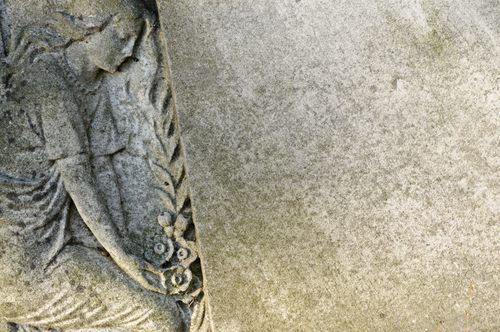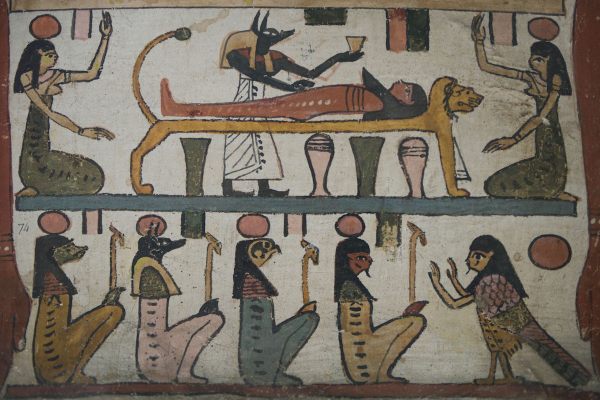The Perpetually Dying Art Of The Small-Town Obituary

(All illustrations by Matt Lubchansky)
After graduating from journalism school, I took a job at a tiny local paper in Northern California. I didn’t know this until I got there, but this paper was one of the few, and one of the last, perhaps, to publish long, reported obituaries for the common man, woman, and, even, child. Writing them became one of my primary tasks. The work was rewarding but difficult—I will never forget doing a two-page spread about the 9-year-old girl who drowned in a creek while having a picnic with her mom, for instance. I read reams of letters, diaries, and yellowed news clippings so old they crumbled in my hands, visited the homes of bereaved families, tracked down old photo albums—all to tell the stories of humans I would never know. I loved it.
Even before that job, though, the obituary form captivated me. You might even say it was an obsession; upon entering parties or business meetings, my mind would flash to what the obituary would be like for the person in front of me. (In my defense, the interest was also literary. They are kind of the ultimate in storytelling.) My mom traces these thoughts back to a serious car accident, about ten years ago. “You are very aware that the end could happen at any time,” she says.
But even though my days as an obituary writer were not that long ago, the culture of obituaries has changed greatly in the last few years. For one thing, newspaper numbers are dwindling: from 1990 to 2006, Pew Research Center calculated a 14 percent drop in daily papers in circulation. Social media has transformed how we communicate, as well, creating constantly pruned self-told stories. The obituary as we know it might be over. How will we remember the dead in the future? And what did we do in the past?

In 1990 there were 1,611 daily papers in circulation. By 2009 there were 1,387, a decrease that only continues, according to the Pew Research Center’s 2014 State of the Media. Fewer papers equal fewer obituaries, which mean a shift in who is awarded space for a reported life story. (Mainly famous people, really.)
I asked Holly Shreve Gilbert, a journalism instructor at Oakland University and interim president of the Funeral Consumers Information Society (yes, a real thing), about the shrinking number of newspapers, and its effect on obituary coverage. First she laughed off her own obituary obsession: “I really am a happy person,” she said. (I could relate.) And then: “Hyper-local journalism is dying, and so is the obituary of the local person.”
This shift in death coverage, however, is more importantly due to the rise of the digital age. With Facebook, Twitter, Snapchat, and Instagram, we are not only able to consume more media, but are able to create more media, media that narrates our lives the way we want it to be narrated—in effect, we have more control over our own life story now than ever.
And this translates to our death story. Today, instead of objective, reported obituaries or even paid, family-written eulogies printed in newspapers, there are sites like legacy.com—which publishes family- or even self-written obituaries online, complete with a guest book for comments—and myebit.com, which allows you to “create a free custom memorial at the world’s largest memorial site.” In February of this year, Facebook changed its policies, allowing you to designate a friend or family member to execute your Facebook “estate,” managing your account after you’ve died. Also in February, the famed neurologist Oliver Sacks, diagnosed with terminal cancer, wrote what was is, in effect, a living obituary in the New York Times, describing his life, and his death, on his own terms. “Over the last few days, I have been able to see my life as from a great altitude, as a sort of landscape, and with a deepening sense of the connection of all its parts,” he wrote. (Sacks died in late August and got an official obituary.)
“Obits have changed a lot over the history of the U.S. and now they’re undergoing another sea change with the rise of digital technologies,” said Janice Hume, journalism professor at Grady College and author of the book Obituaries in American Culture. “For those of us who were traditional newspaper people, the idea of some of the content that comes into these digital obits, particularly message boards or guest books, it’s content that we would never have dreamed of putting in. In guest books, people talk to the dead: ‘Go tell my aunt Marjorie I say hello.’”
“It’s all very soft and loving,” said Dr. Nigel Starck, author of Life After Death: The Art of the Obituary. “But it’s untrustworthy and full of lies. It’s just untrue. It’s rubbish. But people want to express their grief. You cannot trust them as a historical source.”
But then, obituaries were never totally objective.
The word “obituary” comes from the Latin “obit,” or death. The word was first used to refer to death notices printed in British papers in the early 18th century, and the tradition followed to America. In the earliest days, American newspapers didn’t have reporters; families would supply death notices. The tone and style changed significantly over the years.
The “news obituary” started in the early 19th century in America, when voracious readers of local news demanded a significant number of local papers. “When we move into eras with more reporters, obituaries become much more standardized,” said Hume—reporters, that is, and the rise of the funeral industry, she added, where families filled out forms at the funeral homes. Standardization, however, didn’t necessarily result in objective obituaries. Nineteenth century obituaries were filled with syrupy language. “Some people died and they listed the real cause of death, but you also got very sentimental language about death; the deceased would be ‘removed by the omnipotent author,’” she said, “And that was written in newspapers!”
 Teddy Roosevelt’s obituary in 1919 was a very detailed account. (Photo: Public Domain/WikiCommons)
Teddy Roosevelt’s obituary in 1919 was a very detailed account. (Photo: Public Domain/WikiCommons)The industrial revolution changed obituaries again, No longer were the deceased remembered as gallant (men) or gentle (women), but suddenly they were remembered for how much money they had, and how many years they worked. (Even young boys weren’t spared this treatment, said Hume: “Instead of ‘he died,’ it would read ‘his career was cut short.’”)
This changed again with the Civil War. Suddenly, death was everywhere. More than 600,000 men were killed. Obituaries were a way of securing their names in historical record. In the years after, the obituaries became very serious, as “death had become far too familiar,” Hume wrote in her book.
An odd shift came in the late 19th century and early 20th: poetry. When Guy Swain died in 1917 the Delaware Gazette published verse. “A precious one is gone, / A voice we loved is still, / “A place is vacant in our home / Which never can be filled…”
Later, obituaries became almost violent in nature, focusing on the exact cause of death. When Teddy Roosevelt died, in 1919, the first five paragraphs of his obituary in the New York Times explain exactly how he died. “His physicians said that the immediate cause of death was a clot of blood which detached itself from a vein and entered the lungs.” When Louisa May Alcott died, in 1888, the first paragraph of her obituary in the Times included these meticulous details:
For a long time Miss Alcott had been ill, suffering from nervous prostration. Last Autumn she appeared to be improving and went to the Highlands to reside with Dr. Rhoda A. Lawrence. She drove from there into town to visit her father on Thursday last, and caught a cold, which on Saturday settled on the base of the brain and developed spinal meningitis. She died at the Highlands early this morning. Miss Alcott was born on her father’s birthday, and it is singular that she should have followed him so soon to the grave.
And we thought Michael Jackson’s death coverage was bad.
For a while, the obit beat assignment signaled that you were on the lowest rung of the newsroom hierarchy, a stigma that lasted up through WWII. But that began to change, in no small part due to an editor named Alden Whitman, who wrote obituaries in the New York Times from 1965 to 1976. He viewed them as feature writing, as biographies, and was famously profiled in 1966 by Gay Talese in an Esquire story called “Mr. Bad News.”
“For an obituary writer there is nothing worse than to have a world figure die before his obituary is up-to-date,” Talese wrote. “It can be a harrowing experience, Whitman knows, requiring that the writer become an instant historian, assessing in a few hours the dead man’s life with lucidity, accuracy, and objectivity.”
And, for some papers—especially larger papers like the New York Times, the Economist, the Guardian—this remains true today. Obituaries are objective features, written by journalists.
“Obit writers are invisible, writing about people who have ceased to exist. If they’ve written advance obituaries for some publication’s files, and they die before their subjects, the become people who no longer exist writing about people who no longer exist. This is ghostly work,” wrote Marilyn Johnson in her book, The Dead Beat: Lost Souls, Lucky Stiffs, and the Perverse Pleasures of Obituaries.

Margalit Fox, senior writer at the New York Times, has written more than 1,200 obituaries in her 11 years at the job. And, her job? Her job, she says, is to maintain objectivity. I asked her if families, especially today in the digital age, ever try to influence the story. Sometimes, but certainly not always, she said. “What happens, too, is that you do get a sense of which people are trying to control the narrative, families trying to stage manage a story,” she noted, “And very occasionally you get a sixth sense of families trying to do it.” When that happens, she “gently but firmly” puts the families on notice—no eulogies, none of the “flowery encomiums in small town papers, where everyone was a saint and everyone died surrounded by people they loved.”
Not every grieving widower or granddaughter takes kindly to that line of thought.
“I’ve been called a bitch, a bad journalist, every name in the book. But when you calm down and listen to the message again, you realize the family is not actually identifying any issue of fact that you got wrong, it’s simply that what they wanted was a flowery eulogy and what they got was a news story,” she said.
Fox often writes of quirky contenders in history, stories of men and women who changed the world, perhaps only in tiny ways, written as a story, a biography, a fully formed narrative. I still think about the obituary she wrote in 2012 of the man who invented the bar code, a mechanical engineer in training, who sat on the beach and ran his fingers in the sand and had an idea. “The result adorns almost every product of contemporary life, including groceries, wayward luggage and, if you are a traditionalist, the newspaper you are holding.”
The style of legacy.com is very different. A 71-year-old, gloomy-looking man from Oklahoma who “liked to travel, enjoyed people, friends and family and enjoyed running cattle.” A 95-year-old grandmother from Rhode Island, whose “faith in God, her incredibly wonderful soul, her humor, her generosity and charm, and her ‘recipes’ are unforgettable,” wrote a family member in the guest book. Then there are the Facebook pages of people who have died, both famous and not. David Carr’s last post, an article about Brian Williams, is filled with comments lamenting his death. An acquaintance of mine from high school died, a brain hemorrhage in his sleep, almost six years ago. His Facebook page, now labeled a “remembering” page, is filled with comments from friends and family, telling him, in comments as recent as October 2014, how much they miss him and think of him, still.
“When I think of an obituary, it’s as objective as journalism can be, a story on someone’s life,” Gilbert told me. “Now, if it’s on legacy.com or Facebook or a blog, we’re basically whitewashing everyone’s lives. We’re all happy. Everyone is happy.”
That isn’t always the case though. Earlier this year, a Maine woman’s obituary went viral because of its grittiness. Written by her ex-husband, it aimed to capture the pain of her drug addiction. In doing so, her obituary became more of a political screed than a eulogy or news story.
 (Photo: Nagib/shutterstock.com)
(Photo: Nagib/shutterstock.com) Thankfully, though, obituaries aren’t the only record of someone’s life.
My grandmother is now 96 years old. She lives in a nursing home near me in Boston. Fifteen years ago, she suffered a stroke. It paralyzed the majority of her left side, and left her wheelchair bound, though relatively mentally intact. The last few years, however, she has descended into a curious form of dementia—a sort of rational dementia. She tells stories. Long stories. Stories about her life. And, none of them are true.
In reality, my grandmother grew up in the “borscht belt” of upstate New York, daughter of Polish immigrants who opened a hotel. She didn’t go to college, or ever hold a job, like many women in her generation. She married young, and had three kids – including my father, her youngest. Her marriage to my grandfather was glamorous. He made a lot of money. They lived in a beautiful, large house in the nice part of Middletown, NY, and threw parties people talked about for weeks afterward. But it wasn’t a happy marriage. I grew up hearing rumors of cheating, of fighting, of anger.
The stories my grandmother tells about her life now, eight years after the death of my grandfather, are not disjointed or confusing. There are concrete details, albeit completely fabricated details, which repeat themselves from story to story. Timelines seem clear. Narratives have logical flow. She tells stories about working in the dress department at Macy’s, and starting a charity to send young students to medical school. For a while she talked about her work for the rights of the elderly, traveling all over the country, she said, to give speeches in their honor—including a talk to the members of the Supreme Court. Last year, at Passover, she told me she would be starting at Harvard Law School in the fall.
I find these stories fascinating and sad, like I am listening to my grandmother rewrite her own life in her final years —a lucid dream world where she, perhaps, did what she wanted, not what she felt she should.
When I see her, I think of the obituary a journalist would write of her life. And then I think of the one I would give her myself.












Follow us on Twitter to get the latest on the world's hidden wonders.
Like us on Facebook to get the latest on the world's hidden wonders.
Follow us on Twitter Like us on Facebook